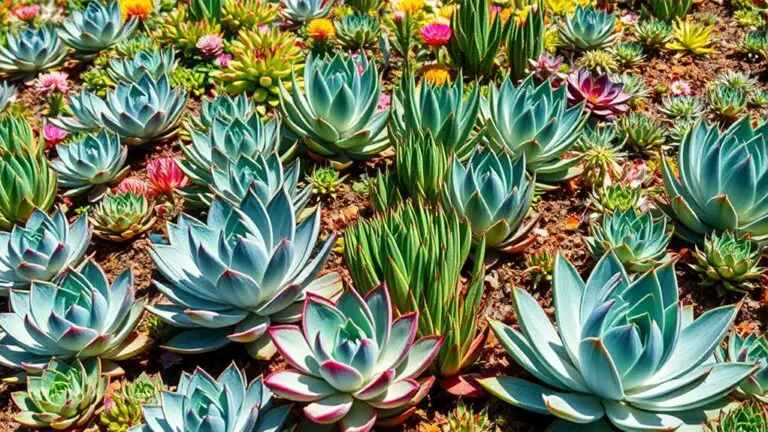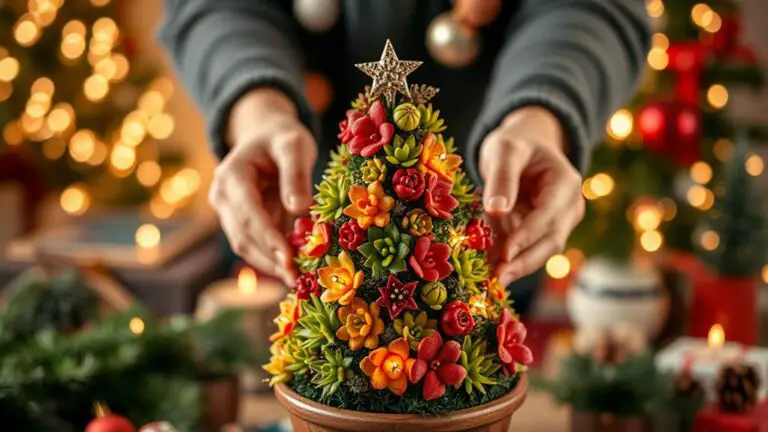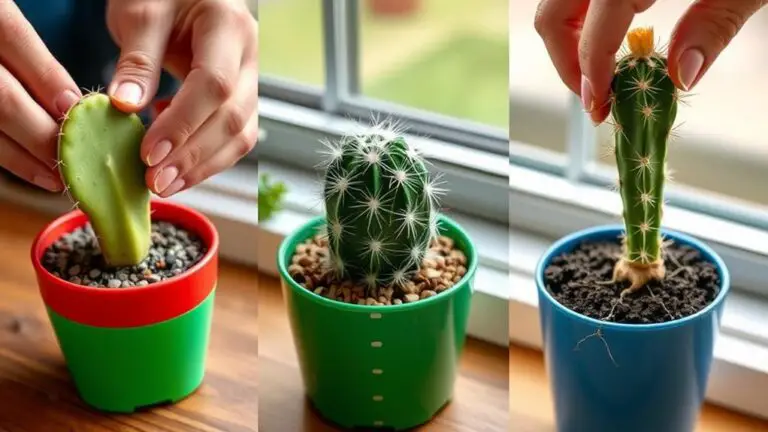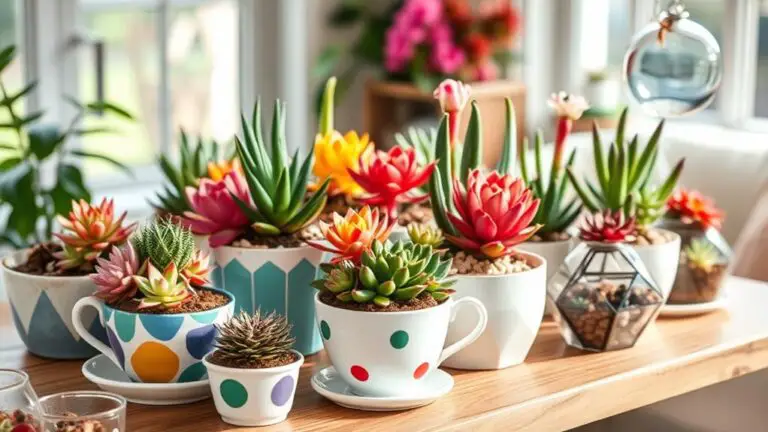10 Essential Tips for Winter Houseplant Care
As winter approaches, your houseplants require special attention to thrive in the colder months. You'll need to adjust their environment, starting with light management and ensuring they get enough sunlight or supplemental grow lights. Don't forget about temperature control; keeping your indoor space between 65-75°F is vital. Humidity levels also play a significant role, with many plants preferring 40-60% humidity. There's more to take into account, from watering adjustments to pest monitoring. Want to keep your plants healthy and vibrant throughout the season? Let's explore these essential tips further.
Increase Light

As winter days grow shorter, it's crucial to move your houseplants closer to south-facing windows to maximize their exposure to natural light.
Plants need plenty of light to thrive, especially during the darker months. If you notice spindly or leggy growth, it may be a sign they aren't getting enough light. In this case, you should move your plants to a brighter spot or consider using supplemental lighting.
Using grow lights can be very effective. Position them 12-24 inches above your plants to guarantee they get the illumination they need.
Rotating your plants every few days will help them receive even light distribution, promoting straight and balanced growth. Clean your windows regularly to let in more natural light, and consider using reflective surfaces to enhance light penetration.
Don't forget to water your plants appropriately, as they may need less water in winter. Check the humidity levels too, since indoor air can become dry.
You might need to increase humidity around your plants. Reducing the amount of water and increasing light can make a big difference.
Be Mindful of Temperature
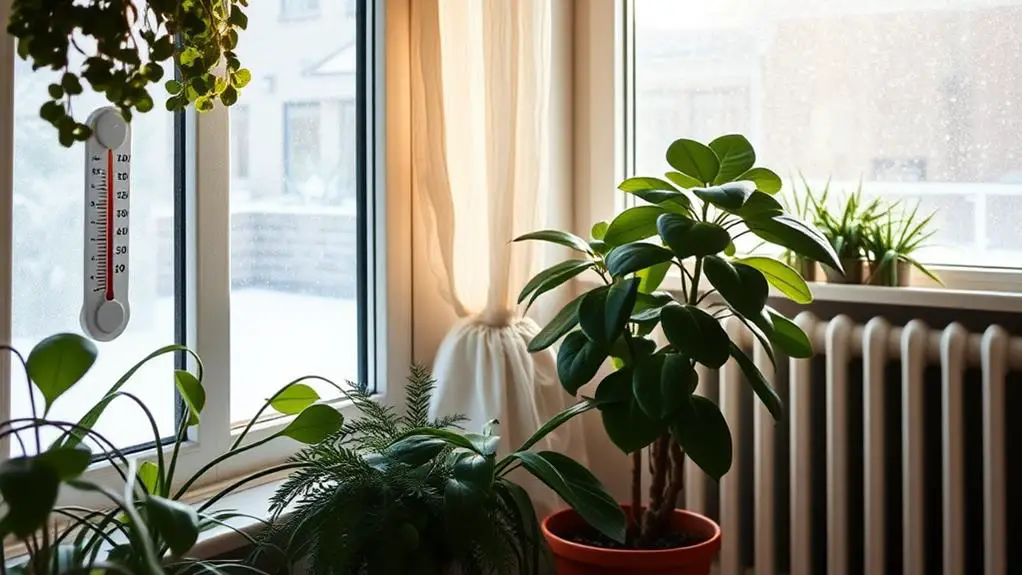
While increasing light is important for your houseplants during winter, it's equally essential to be mindful of temperature. Most houseplants thrive in temperatures between 65-75°F, so you need to maintain this range for ideal growth.
If your home gets too cold, your plants might suffer. Sudden changes, like drafts from open windows or doors, can stress your plants and cause their leaves to drop.
Keep your plants away from heating sources, too, as direct heat can be just as damaging as cold. Nighttime temperatures should stay above 50°F to protect your plants from cold damage, especially on freezing nights.
Using a thermometer to monitor your indoor temperature is a simple yet effective way to guarantee stable conditions for your plants.
Embrace Dormancy
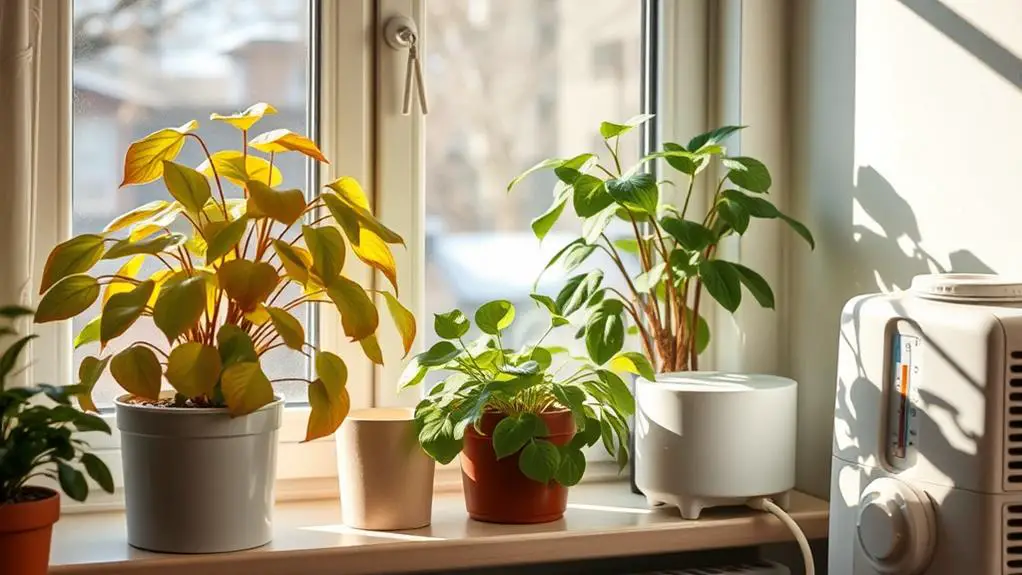
During winter, many of your houseplants enter dormancy, slowing their growth due to less light and shorter days.
You'll need to adjust your watering routine and let the soil dry out completely before watering again.
Look for signs like wrinkling leaves or drooping stems to know when your plants are thirsty, and remember to pause fertilizing until spring.
Adjust Watering Frequency
In the winter months, many houseplants enter a dormant phase, considerably decreasing their water requirements. To help your indoor plants thrive, you need to adjust watering frequency and give them less water.
Before you reach for the watering can, check the moisture level of the potting mix. Insert your finger about an inch into the soil. If it feels dry at that depth, it's time to water. Overwatering can lead to root rot, especially when the soil stays cold and wet, so it's safer to let the plants dry out a bit between waterings.
Typically, houseplants need watering every two weeks during winter. However, succulents should be watered every two to three weeks, and cacti may not need water at all while they're dormant.
Look for signs of thirst in your plants, like wrinkling leaves or drooping stems. These indicators mean it's time to adjust your watering practices.
Recognize Dormant Signs
Many houseplants enter a dormant phase during winter, considerably altering their care needs. During this period, you'll notice that growth slows down due to reduced light and shorter days. Recognizing these signs of dormancy is essential to providing the right care for your plants.
First, keep an eye on the leaves. Dormant plants might shed leaves as a natural response to the season. Don't worry—this is normal and helps the plant conserve energy.
Second, adjust your watering routine. Dormant plants need less water. Wait until the soil is completely dry before you water again. This prevents overwatering, which can harm your plants.
Third, watch for wrinkling leaves or drooping stems. These are signs that your plant needs water, even in its dormant state.
Fourth, remember to avoid fertilizing. Since your plant's growth has slowed, extra nutrients can actually do more harm than good.
Here's a quick list to help you:
- Monitor leaf drop: It's a natural part of dormancy.
- Adjust watering: Let the soil dry out completely before watering.
- Check for signs of thirst: Look for wrinkled leaves or drooping stems.
- Skip fertilizing: Your dormant plant doesn't need it.
Dust Off Leaves
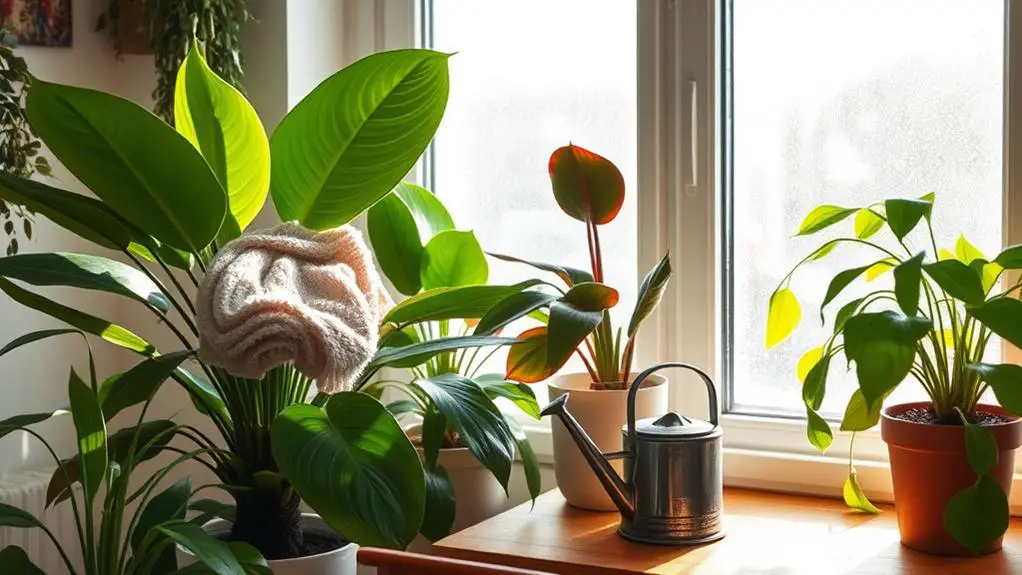
A layer of dust on your houseplant's leaves can block essential light and hinder photosynthesis, making regular cleaning crucial for their health.
To keep your plants thriving, you should clean their leaves every few weeks. Start by putting on some dusting gloves and using a damp cloth to gently wipe each leaf. This simple step guarantees that your plants can absorb maximum light, promoting healthy growth.
For an even more effective cleaning, add a few drops of mild soap or lemon juice to the water you use. This helps break down any stubborn accumulated dust. Be gentle while wiping to avoid damaging the leaves.
You can also stand your plants in a lukewarm shower for about five minutes. This method is great for removing dust without harming the foliage.
Forgo Fertilizer
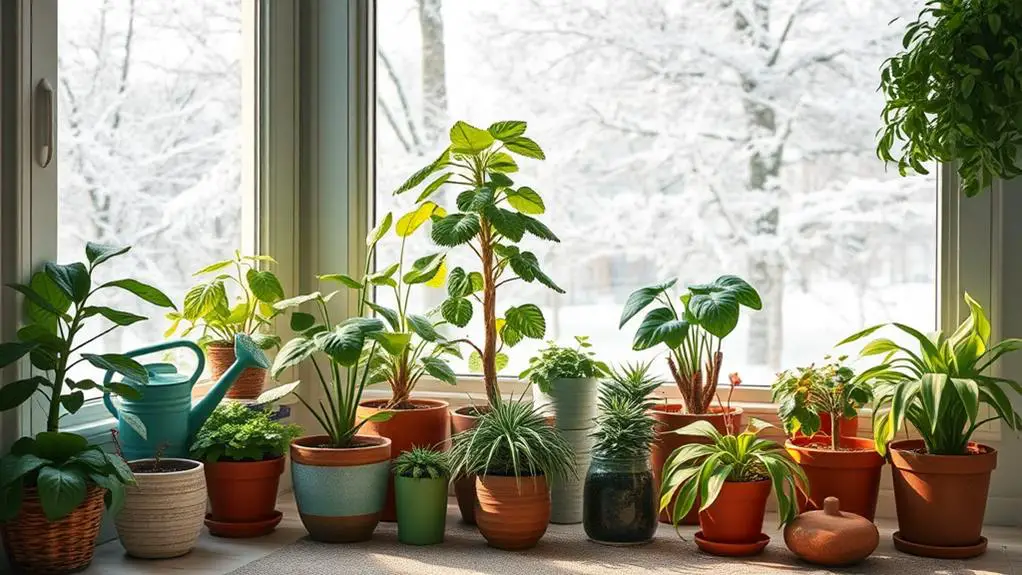
During winter, most houseplants enter a resting phase and don't need extra fertilizer, so it's best to pause fertilization until spring.
Over-fertilizing can harm your plants by disrupting their natural growth cycle.
If your plants are actively growing and getting plenty of light, you might use a half-strength fertilizer, but keep a close eye on them to avoid overfeeding.
Pause Fertilizer Application
When winter arrives, it's essential to adjust your houseplant care routine, and one crucial step is to pause fertilizer application. During the winter months, most houseplants enter a dormant phase, which means they've greatly reduced growth activity. Fertilizing during this time can stress the plants or cause nutrient imbalances.
To help your plants thrive, follow these steps:
- Pause all fertilization in the fall: As the days get shorter and temperatures drop, gradually stop fertilizing your houseplants. This adjustment aligns with their natural growth cycle.
- Monitor plant health: Keep an eye on your plants throughout the winter months. While they usually don't need extra nutrients, observing their condition guarantees you catch any issues early.
- Resume in early spring: Once you notice new growth in early spring, you can start fertilizing again. This is the time when plants begin to wake up and require more nutrients for healthy development.
- Be cautious with actively growing plants: If any of your plants are still growing actively and getting plenty of light, use a half-strength fertilizer sparingly. But remember, this isn't typically necessary.
Nutrient Needs Decline
As winter sets in, you'll notice that most houseplants enter a dormant phase, considerably reducing their nutrient needs. During this time, it's best to pause fertilization. The plants aren't actively growing, and adding extra nutrients can actually disrupt their natural rest period. This can lead to stress and make it harder for them to thrive come spring.
For most of your houseplants, forgoing fertilizer during the winter is the way to go.
However, there are exceptions. If you have plants that receive ample light and continue to grow, they might still benefit from a bit of fertilization. In such cases, use a half-strength, balanced fertilizer and closely monitor health.
Watch for signs like new growth or the greening of leaves, which can indicate the plant's nutrient needs.
Avoid Over-Fertilizing Dormant Plants
Understanding the importance of avoiding over-fertilizing dormant plants is essential for their winter care. During winter, your houseplants typically enter a dormant phase, meaning they won't need extra nutrients.
Over-fertilizing dormant plants can cause nutrient burn, harming their health. Yellowing leaves and stunted growth are signs you might be overdoing it.
Here's what you need to do:
- Pause Fertilizer: Stop applying fertilizer until spring. Your plants don't actively use nutrients during dormancy.
- Monitor Plant Health: Keep an eye on your plants. Look for yellowing leaves or stunted growth, which indicate the need for a fertilizer pause.
- Adjust for Active Growth: If a plant remains actively growing due to sufficient light, use only half-strength fertilizer to avoid nutrient burn.
- Water Wisely: It's safer to underwater than to overwater or over-fertilize. Overdoing nutrients can disrupt your plants' natural cycle.
Vacation With Ease
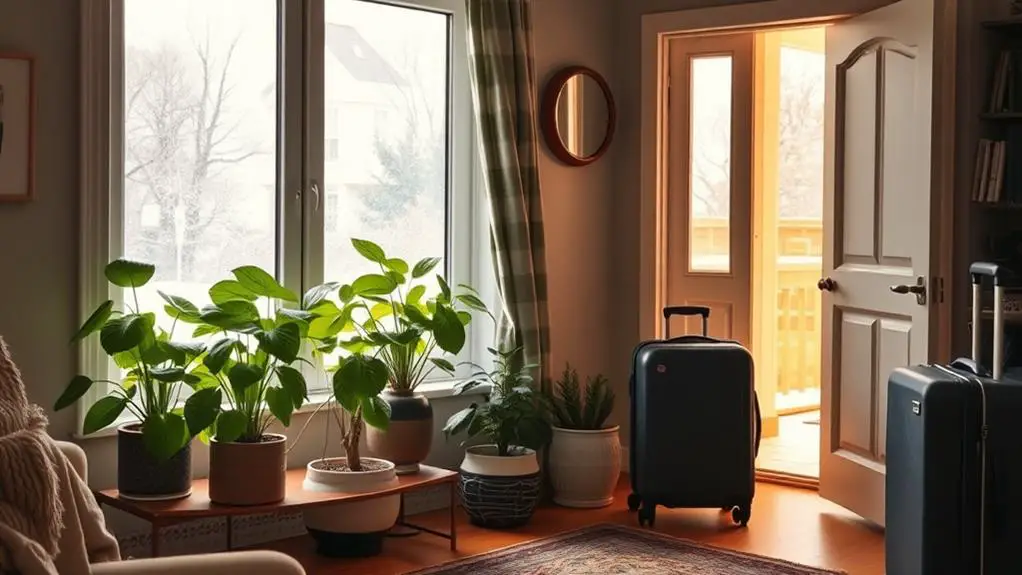
Planning a winter getaway doesn't mean your houseplants have to suffer. Before you leave, thoroughly water your plants to guarantee their water level is sufficient for your absence.
It's a good idea to move plants to a slightly shaded area. This step keeps plants away from direct sunlight and helps them require less water.
Consider using self-watering systems or water globes. These tools provide a steady supply of moisture, so your plants won't need watering as frequently.
It's also smart to keep plants away from heat sources like radiators or vents. Heat can dry out the soil faster, making your plants need more frequent watering.
For shorter vacations, most indoor plants can survive up to a week without any issues.
However, for longer trips, asking a friend or a plant sitter to check on your plants can bring peace of mind. They can guarantee the water level is adequate and move plants if necessary.
Accept Leaf Loss
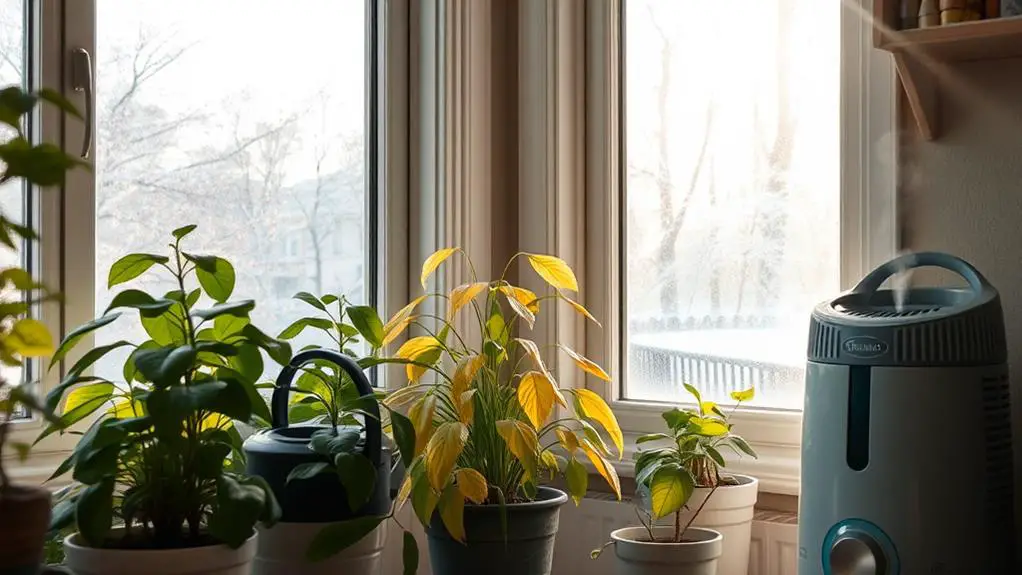
Leaf loss in winter is completely normal and nothing to worry about.
Your plants are just conserving energy as they adjust to the shorter days and lower light levels.
This natural response helps them survive the winter and sets them up for healthier, fuller growth in the future.
Natural Seasonal Response
As winter sets in, many houseplants will naturally start shedding some leaves, a normal response to the season's reduced light levels and shorter days.
It's important to understand that this leaf drop is a common seasonal change and helps plants focus their resources on new growth. While some leaf loss is typical, excessive dropping may indicate other stress factors that require your attention.
To navigate this natural seasonal response, consider these tips:
- Monitor Light Levels: Verify your houseplants are getting as much natural light as possible. Move them closer to windows or use grow lights if necessary.
- Check for Pests: Sometimes, excessive leaf drop can be a sign of pest issues. Inspect your plant leaves regularly for any signs of infestation.
- Trim Overgrown Plants: Pruning can help manage leaf drop and encourage fuller, bushier growth. It also helps the plant conserve energy.
- Stay Calm: Remember, some leaf loss is normal and part of your plant's adaptation to winter. Don't panic; instead, focus on creating a supportive environment.
Energy Conservation Strategy
It's natural for houseplants to shed leaves during winter as a strategy to conserve energy. Many plants face reduced light conditions and need to prioritize their resources. This leaf drop helps them adjust to the seasonal changes and maintain healthy growth.
Leaf Drop Benefits
| Reason | Benefit |
|---|---|
| Conserve Energy | Focuses on essential foliage |
| Adjust to Season | Adapts to lower light levels |
| Promote Health | Prepares for future growth |
Don't worry if you see some leaves falling; it's part of the plant's energy conservation strategy. By shedding leaves, plants can direct their energy to the remaining foliage, ensuring they stay strong and healthy. This isn't a sign of poor plant health but a natural response to winter.
Keep an eye on your plants to monitor for stress, but remember that some leaf loss is expected during this time. If you have overgrown plants, a little pruning can help maintain their appearance and encourage bushier growth later on. Accepting leaf drop during winter allows your houseplants to conserve energy and be ready for the return of ideal conditions.
Encouraging Future Growth
During winter, accepting leaf loss in your houseplants can set the stage for encouraging future growth.
It's natural for plants to drop leaves as they conserve energy due to reduced light exposure. This process helps them focus on new, healthier growth.
Here are some tips to help you manage leaf loss and encourage future growth:
- Light Exposure: Guarantee your plants get maximum light during the shorter days. Move them closer to windows or provide supplemental lighting if necessary.
- Proper Watering: Adjust your watering routine. Overwatering can harm your plants, so let the soil dry out a bit between waterings. This helps prevent root rot.
- Consistent Care: Maintain a regular care routine. Even small changes can stress your plants, so keep their environment stable.
- Seasonal Changes: Understand that leaf loss is part of your plants' adaptation to winter. Trim older, yellowing leaves to redirect energy to new growth.
Adjust Watering Techniques
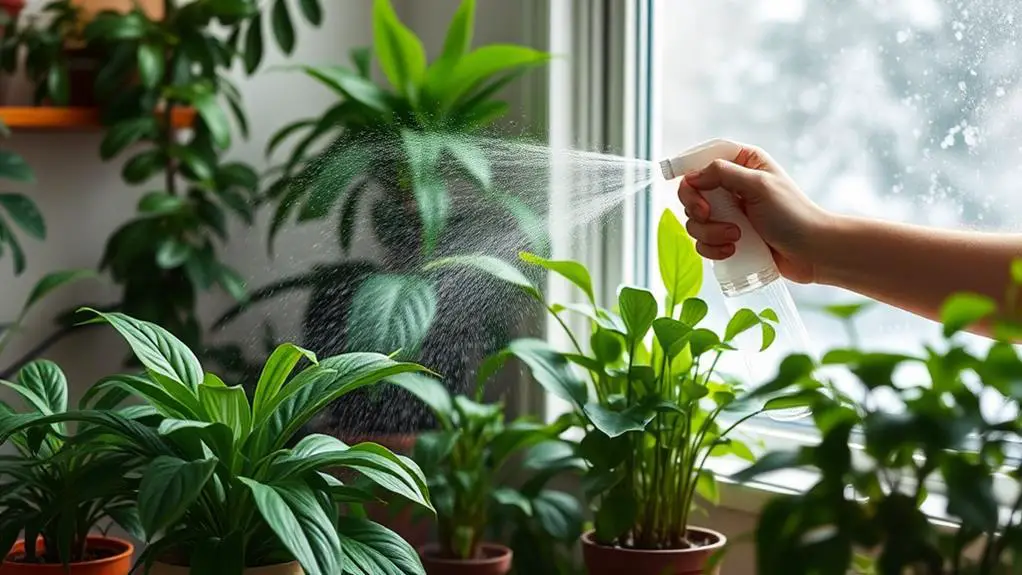
How often should you water your houseplants in winter? During the colder months, most houseplants need considerably less water. You'll generally find that watering once every two weeks is enough, while succulents might only need watering every two to three weeks. It's important to adjust watering techniques accordingly.
Before you water, always check the moisture level of the soil. Insert your finger into the potting mix; only water if it feels dry. Overwatering can be a major problem in winter, leading to root rot. Make sure to use room temperature water for better absorption and to avoid shocking your plant's roots.
Here's a quick guide to help you:
| Tip | Description |
|---|---|
| Water less often | Most houseplants: every two weeks; succulents: every two to three weeks. |
| Check moisture level | Insert finger into soil; water only if dry. |
| Avoid overwatering | Overwatering leads to root rot in cold conditions. |
| Use room temperature water | Prevents shocking roots and aids absorption. |
| Monitor for thirst signs | Look for wrinkling leaves or drooping stems, but be cautious of underwatering. |
Ensure your pots have good drainage to prevent waterlogging. Watch for signs of thirst, like wrinkling leaves or drooping stems. Remember, it's safer to underwater than overwater in winter.
Manage Humidity Levels
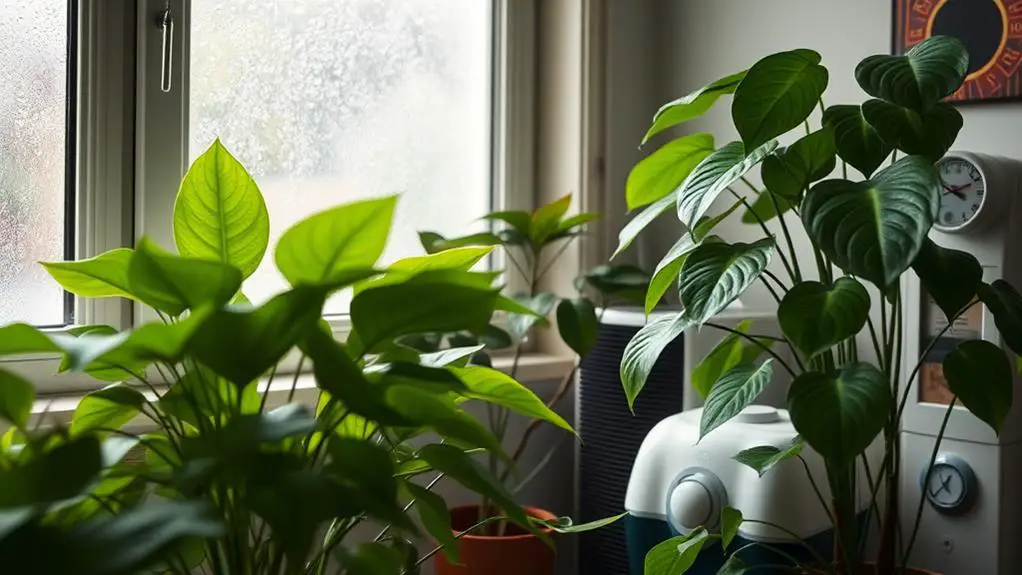
Why is managing humidity so essential for your houseplants in winter?
During the colder months, indoor humidity often drops to around 10-20%, while most tropical plants need about 40-50% humidity to thrive. Without proper moisture, your plants may struggle, showing signs of stress like browning leaf edges and stunted growth.
To help your plants, follow these steps:
- Use a humidifier: Placing a room humidifier near your plants can greatly boost humidity levels, creating a more suitable environment for them.
- Group your plants: Grouping plants together helps create a humid microclimate, allowing them to benefit from each other's moisture release.
- Set up pebble trays: Place pots on stones above water trays. This method increases humidity without risking root rot, as the stones keep the pots elevated and away from direct contact with water.
- Monitor with a hygrometer: Regularly check the humidity levels with a hygrometer to verify conditions stay ideal for your plants, especially during the dry winter months.
Avoid misting plants, as it's generally ineffective. The moisture evaporates quickly and doesn't provide lasting benefits.
Monitor for Pests

Keeping an eye out for pests is vital to guaranteeing your houseplants stay healthy throughout the winter. Regularly inspect the undersides of leaves and stems for common pests like aphids, spider mites, and mealybugs. These tiny invaders thrive in indoor environments, especially during the colder months. By catching them early, you can prevent significant damage to your plants.
It's also a good idea to quarantine any new plants for at least four weeks before adding them to your collection. This precaution helps prevent the spread of pests to your existing plants. During this time, monitor the new plants closely for any signs of infestation.
Utilize eco-friendly pest control options such as neem oil or insecticidal soap. These solutions are effective and won't harm your plants. If you spot any pests, treat the affected areas promptly to manage the infestation.
Keeping your plant area clean is another important step. Regularly clean leaves and remove any debris around your plants. This habit can deter pests from settling in.
Frequently Asked Questions
What to Feed Indoor Plants in Winter?
In winter, most houseplants don't need fertilizer. If your plants are actively growing, use half-strength fertilizer. For tropical plants, a diluted, balanced fertilizer works best. Always check individual plant needs and avoid over-fertilizing during dormancy.
How to Prep House Plants for Winter?
To prep house plants for winter, move them closer to south-facing windows for more light, keep temperatures steady, adjust watering routines, clean leaves, and boost humidity with a humidifier. This way, your plants will thrive.
How Often Should You Water Indoor Plants in Winter?
You should water indoor plants in winter every two weeks, but always check the soil moisture first. If the soil feels dry about an inch deep, it's time to water. Remember, it's safer to underwater than overwater.
How to Keep a Plant Alive During Winter?
To keep a plant alive during winter, guarantee adequate light by moving it closer to windows or using grow lights. Adjust watering habits, maintain stable temperatures, monitor humidity, and inspect for pests. These steps will help your plant thrive.
Conclusion
Taking care of your houseplants during winter doesn't have to be hard. Just remember to give them enough light, keep the temperature cozy, and let them rest. Dust off their leaves, skip the fertilizer, and don't worry about a few lost leaves. Adjust your watering routine and keep an eye on humidity and pests. With these tips, you're set for a season of healthy, happy plants. You've got this, and your plants will thank you!



